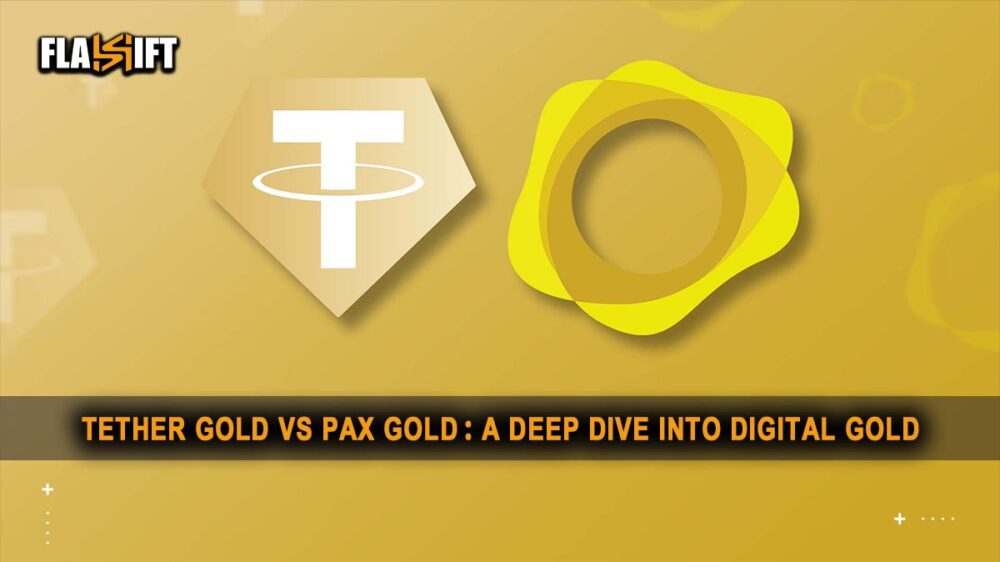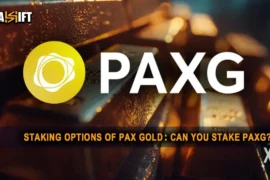In the evolving world of digital assets, gold-backed stablecoins like Tether Gold and PAX Gold are redefining how investors gain exposure to precious metals without holding physical bullion. Tether Gold vs PAX Gold has become a key comparison for those seeking security, liquidity, and trust in the blockchain-based gold market. While both tokens are backed by real gold and aim to combine the stability of a traditional asset with the convenience of crypto, their underlying mechanisms, custodianship models, and use cases differ significantly.
In this deep dive, we’ll unpack the nuances between these two digital gold standards to help you make an informed choice.
Tether Gold vs PAX Gold: Overview of Both Tokens and Their Respective Issuers
When you look at Tether Gold versus PAX Gold, the story isn’t just about who offers gold on the blockchain. It starts with who’s issuing these tokens, because that foundation shapes everything — from trust to transparency to how confident you can be holding them over years.
Tether Gold (XAUT) comes from the folks behind USDT, the stablecoin giant that’s been dominating crypto for years. Every XAUT token represents a troy ounce of gold stored somewhere in Swiss vaults. The problem? Tether hasn’t been especially clear about the details — the exact vaults, how often audits happen, or how you can independently verify the gold backing. Given Tether’s history of opacity around its stablecoin reserves, some investors can’t help but be cautious.

Flip the page to PAX Gold (PAXG), and you get something very different. Issued by Paxos Trust Company, a fully regulated financial firm under New York State’s watchful eye, PAXG offers tangible reassurance. Each token corresponds to a specific, identifiable gold bar held in high-security Brink’s vaults. The company routinely publishes audits, and you can even look up which exact bar you own. That kind of transparency builds confidence, especially for investors who aren’t just chasing price but want clear proof behind their asset.
So really, this isn’t just a battle of gold tokens. It’s about whether you’re comfortable with your issuer and how much visibility you get into the actual gold backing your investment. For anyone thinking long term, that trust and transparency aren’t just nice-to-haves — they’re essentials.
Price Stability and Trustworthiness
When you dig into Tether Gold vs PAX Gold, both tokens promise to mirror the price of real gold ounce for ounce—but the devil’s in the details. In a perfect world, XAUT and PAXG would always trade exactly at spot price, but on the ground you’ll notice Tether Gold often carries a slightly wider bid‑ask spread, especially on smaller exchanges or DEX pools. That means you might pay a premium to get in—or take a hit when you cash out. PAX Gold, backed by Paxos’s tight institutional listings and deeper liquidity, usually stays closer to the true gold price, so your entry and exit costs tend to be more predictable.
Trust, though, isn’t just about price tags—it’s about knowing your gold is really there. Tether’s proof‑of‑reserves reports have sometimes come late or without the level of detail you’d hope for, which leaves a nagging “what if?” in the back of your mind. Paxos, on the other hand, publishes regular third‑party attestations and even lets you look up the serial number on your specific gold bar. For anyone who’s ever worried, “Is my digital gold actually sitting in a vault?” that extra transparency can make PAX Gold feel like the safer bet. (Passive Income with XAUT)
Fees, Custody, and Availability
When you line up Tether Gold vs PAX Gold on fees, custody, and availability, the differences become really clear—and they matter more than you might think. With Tether Gold, every mint or redeem comes with a variable fee and since you’re relying on whichever exchange you use, trading costs can jump around depending on liquidity.
There’s also the question of pooled custody in Swiss vaults without serial‑number guarantees, which is fine if you trust the system—but it doesn’t leave much room for personal verification.
Paxos takes a different route: a straightforward 0.02% custody fee each month and redemption built into tight spreads, so you know exactly what you’re paying. Each PAXG token points to a specific gold bar in Brink’s vaults—serial number and all—giving you that extra peace of mind.
Plus, with PAXG listed on major regulated platforms from Coinbase to Bitstamp, getting in or out is typically smoother and more transparent, especially if you’re juggling compliance or larger orders.
Which One Works Better for Long-Term Investors? Tether Gold vs PAX Gold

Investing in gold has always been about one thing: preserving value. But in a world where digital assets are reshaping how we own and transfer value, tokenized gold has emerged as a compelling bridge between traditional stability and modern flexibility.
Among the tokenized gold assets, Tether Gold (XAUT) and PAX Gold (PAXG) are the two main players. Both claimed to be backed by real, physical gold. Both live on the blockchain. But they are not the same and for a long-term investor, the differences matter. Let’s break it down with clarity and depth — no fluff, no bias.
Trust and Regulation: Not All Gold Tokens Are Created Equal
Start with the foundation: who’s behind the token, and how are they regulated?
PAXG is issued by Paxos, a regulated financial institution based in New York. Paxos doesn’t just claim to have gold backing its tokens — it’s licensed, audited, and subject to U.S. oversight. Every PAXG token corresponds to a specific gold bar in LBMA-approved vaults. You can even look up the serial number of your bar.
XAUT is issued by Tether, and the gold is reportedly held in Swiss vaults. The ownership structure is less transparent, and there’s no bar-level allocation for retail holders. Also, Tether as an entity doesn’t exactly have a spotless record when it comes to transparency, especially given its ongoing scrutiny over USDT reserves.
So, from a regulatory and transparency lens, PAXG is just more solid. It’s not even close.
Liquidity and Exit Options: Accessibility is Key
Long-term doesn’t mean illiquid. Even if you plan to hold for years, the ability to rebalance, sell, or move funds quickly matters.
PAX Gold has broader exchange support. It trades on Coinbase, Kraken, Binance, and dozens of other platforms. That means tighter spreads, more volume, and easier access whether you’re buying or selling.
XAUT, in contrast, has more limited availability. It’s listed mainly on Bitfinex, and a few smaller venues. You can get it, but it’s not nearly as fluid.
For the long-haul investor who values flexibility without friction, PAXG is far more practical.
Fees, Redemption, and Custody: Subtle but Important
Now let’s talk mechanics. Neither token charges a custody fee, and both run on Ethereum, meaning you’ll face gas fees for transfers. PAXG has a 0.02% transaction fee, which is negligible for most holders.
Where things get interesting is redemption.
- XAUT allows physical redemption — but only if you own at least 430 tokens (one full London Good Delivery gold bar). That’s a massive barrier for the average investor.
- PAXG also supports physical redemption, but through Paxos and under similar large-scale conditions.
So realistically, for most retail investors, neither will be redeemed for physical gold, and that part of the pitch is largely symbolic. Still, the way Paxos manages custody — through partnerships with Brinks and regulated custodians — offers a clearer, more secure path if it ever came to that.
Risk Management: Stability Isn’t Just About Price
Gold’s appeal is in its stability. But in tokenized form, you also inherit smart contract and counterparty risks.
With PAXG, the issuer is regulated, the custody is insured, and audits are routine. That lowers your tail risk dramatically.
With XAUT, the technical structure is sound, but the broader concerns around Tether’s governance, audit practices, and cross-product exposure (especially USDT) raise red flags for anyone who’s seen how quickly trust can vanish in crypto.
If you’re building a long-term portfolio that favors risk-adjusted safety, PAXG is the more responsible play.
So, Which One Works Better for Long-Term Investors?
If we’re being honest, both tokens do what they’re supposed to: give you digital access to gold. But the quality of execution differs. As a long-term investor, your priorities should be:
- Is the token backed by real, verifiable gold?
- Is it issued by a trustworthy, regulated institution?
- Is it easy to buy, hold, and sell over time?
- Is the ecosystem around it stable?
PAXG answers “yes” to all of the above. XAUT ticks some boxes, but leaves others blank or vague.
That’s not to say XAUT is useless — but it’s simply not built with long-term, conservative investors in mind. It’s harder to access, less transparent, and comes with more baggage than it needs to.
Final Words
If your strategy is to hold a gold-pegged asset as a long-term hedge, something that combines the timeless appeal of gold with the efficiency of crypto, PAX Gold (PAXG) is the more mature, investor-grade product.
Tether Gold (XAUT) may appeal to traders or institutions looking for a different custody setup, but for most long-term holders, it lacks the regulatory sharpness and infrastructure needed to be a truly stable store of value. In the battle of Tether Gold vs PAX Gold, the latter feels like the safer vault.
FAQ
- Can I physically redeem my tokens for gold bars with both XAUT and PAXG?
Yes, but only in large quantities—typically one full gold bar (around 430 tokens). Both issuers cater mainly to institutional investors for physical redemption, making it impractical for most retail holders.
- How transparent are the audits behind these tokens?
PAX Gold offers regular, public third-party audits with verifiable serial numbers of gold bars. Tether Gold’s audits and transparency are less frequent and detailed, raising questions among cautious investors.
- Does owning XAUT or PAXG expose me to additional risks beyond gold price fluctuations?
Yes. Both carry counterparty and smart contract risks since they rely on their issuers and Ethereum’s blockchain. PAXG’s regulated status reduces some of this risk compared to XAUT.
- Which token offers better liquidity and easier trading options?
PAXG is listed on more major exchanges with higher trading volumes, making it easier to buy and sell. XAUT has more limited exchange support and lower liquidity.
- Are there notable differences in fees when buying, holding, or transferring these tokens?
Both tokens charge minimal custody fees (effectively none), but Ethereum gas fees apply. PAXG may have small transaction fees; XAUT’s fee structure is less transparent, potentially leading to higher hidden costs.







